Are your strawberry plants not producing any fruit? I understand how frustrating that can be. But don’t worry, I’m here to help you troubleshoot the problem and get your strawberry plants back on track to a bountiful harvest!
There can be several reasons why your strawberry plants are not producing fruit. It could be due to poor growing conditions, watering issues, pests or diseases, improper fertilizing, or even the age of the plant. Let’s explore these factors in more detail so we can find a solution together.
Key Takeaways
- Poor growing conditions, such as excessive heat or cold snaps, can impact fruit production in strawberry plants.
- Consistent moisture is essential for strawberry plants, so make sure you’re providing the right amount of water.
- Pests and diseases can hinder fruit production, so regular monitoring and appropriate treatment are crucial.
- The right balance of nutrients is necessary for healthy growth and fruiting, so be mindful of proper fertilization.
- Most strawberry varieties produce little to no fruit in the first year, so don’t be discouraged if you don’t see fruits right away.
Now that we’ve identified some of the potential issues, it’s time to dive deeper into each one and learn how to overcome them. Stay tuned for the next sections where we’ll discuss poor growing conditions, watering issues, pests or diseases, improper fertilizing, and the age of the plant. By addressing these factors, you’ll soon have a thriving strawberry garden with abundant fruit!
Poor Growing Conditions
Strawberry plants rely on favorable growing conditions to produce an abundant crop of juicy berries. However, poor growing conditions can hinder their ability to thrive and bear fruit. Let’s explore some of the factors that contribute to a lack of fruit on strawberries.
First and foremost, strawberry plants prefer well-draining, organic soil. This type of soil allows for proper root development and prevents waterlogged conditions that can be detrimental to the plants. When the soil doesn’t drain well, it can lead to root rot and inhibit the plant’s ability to produce fruit.
Aside from soil quality, strawberry plants also require a combination of warm days and cool nights. This temperature balance is necessary for optimal flower development and fruit set. Unfortunately, if the weather is excessively hot or if there’s a sudden cold snap during the blooming period, it can disrupt the plants’ reproductive cycle, resulting in poor fruit production.
Additionally, strawberry plants need access to adequate sunlight for photosynthesis and overall growth. Insufficient sunlight can limit the plants’ ability to produce enough energy for fruiting. If the strawberry bed is located in a shaded area or if neighboring plants obstruct the sunlight, it can contribute to a lack of fruit on the strawberries.
A table below summarizes the main causes of poor growing conditions for strawberry plants:
| Factors | Impact on Strawberry Plants |
|---|---|
| Poor soil drainage | Root rot, inhibited fruit production |
| Extreme temperatures | Disrupted reproductive cycle, poor fruit set |
| Inadequate sunlight | Insufficient energy for fruiting |
Quote:
“Creating optimal growing conditions for strawberries is key to encouraging fruit production. Providing well-draining soil, protecting against extreme temperatures, and ensuring adequate sunlight are crucial for a bountiful strawberry harvest.” – Me, a Strawberry Enthusiast
Improving growing conditions for strawberry plants requires careful attention to soil quality, climate, and light exposure. By addressing these factors, you can set the stage for a thriving strawberry patch and enjoy a plentiful harvest of sweet, succulent berries.
Stay tuned for the next section, where we’ll explore the impact of watering issues on strawberry plant fruit production.
Watering Issues
Proper watering is crucial for the successful growth and fruit production of strawberry plants. These plants have shallow root systems, which means they require consistent moisture to thrive. However, watering issues can arise if the plants receive too little or too much water.
If strawberry plants are not receiving enough water, it can lead to limited fruiting. When the soil becomes dry, the plants may struggle to develop and produce an abundant harvest. To avoid this, it is important to monitor the moisture levels regularly and ensure the plants are adequately hydrated.
On the other hand, excessive watering can also be detrimental to strawberry plants. When the plants are overwatered, it can result in the rotting of the plant’s crowns, which are essential for growth and fruiting. Excessive water can also hinder the overall growth and development of the plants, leading to subpar fruit production.
In order to maintain the ideal moisture balance for strawberry plants, it is important to water them consistently and evenly. Water deeply, but avoid allowing the soil to become waterlogged. Monitor the soil’s moisture levels and adjust the watering accordingly, especially during periods of heavy rainfall or drought.
Signs of Watering Issues
It’s important to pay attention to signs that indicate watering issues in strawberry plants. Some common signs of inadequate watering include:
- Wilting leaves and stems
- Dry and crumbly soil
- Poor fruit development
Conversely, signs of excessive watering may include:
- Yellowing leaves
- Mushy crowns
- Stunted growth
By closely monitoring the plants and adjusting the watering regimen accordingly, you can ensure that your strawberry plants receive the optimal amount of water to promote healthy growth and maximize fruit production.
Pests or Diseases
When it comes to strawberry plant health and fruit production, pests and diseases can pose significant challenges. These intruders can disrupt the growth and development of your beloved strawberries, leaving you with a less-than-satisfying harvest. It is crucial to be vigilant and take appropriate measures to prevent or manage pests and diseases that can impact your strawberry plants.
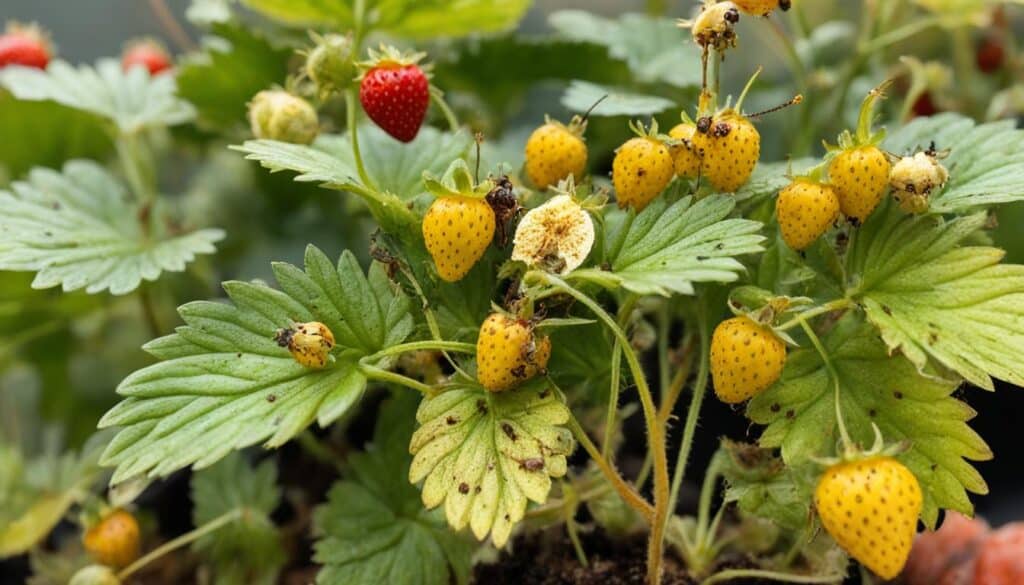
Pesky Pests
Pests like Lygus bugs can infest strawberry plants, causing damage to the foliage and limiting fruit production. These bugs feed on the flowers and developing fruits, leading to distorted berries or no fruit at all. It is important to regularly inspect your plants for signs of pest infestation, such as chewed leaves or deformed berries.
By implementing proper pest control measures, such as using insecticides or employing natural predators like ladybugs, you can safeguard your strawberry plants from these troublesome invaders. Maintaining a healthy and pest-free environment will significantly improve your chances of a bountiful harvest.
Dreaded Diseases
Strawberry plants are susceptible to various diseases, and these can have a detrimental effect on their fruit production. One of the common diseases that impact strawberry plants is root rot. This fungal disease affects the roots, leading to poor nutrient uptake and stunted growth. As a result, the plants may struggle to produce flowers and fruit.
To curb the spread of diseases, it is crucial to practice good hygienic practices, such as removing and destroying infected plants or debris. Additionally, providing adequate drainage and avoiding overwatering can help prevent disease development. If necessary, you can also consider using fungicides or beneficial microorganisms to combat strawberry plant diseases and promote overall plant health.
“Pests and diseases can be real nuisances when it comes to strawberry plant health and fruit production. Regular monitoring, proper pest control, and disease management techniques are essential to protect your precious strawberry crop.” – Me
Poor or Improper Fertilizing
Strawberry plants require the right balance of nutrients for healthy growth and fruit production. Insufficient or excessive fertilizer can be detrimental. Too little fertilizer can result in poor plant growth, while too much nitrogen can result in excessive foliage growth with limited fruiting. It is important to provide proper nutrients through organic materials and avoid over-fertilization.
When it comes to fertilizing your strawberry plants, it’s essential to strike the right balance. Fertilizers provide the necessary nutrients for the plants to thrive, but poor or improper fertilizing practices can have negative consequences.
The Consequences of Poor Fertilizing
Using poor fertilizing techniques or applying an improper fertilizer can lead to various issues with strawberry plant health and fruit production. Let’s take a closer look at the consequences:
- Poor Plant Growth: Insufficient fertilizer can result in stunted growth and weak plants. Without an adequate supply of nutrients, the plants may struggle to develop a robust root system, which is crucial for absorbing water and nutrients from the soil.
- Excessive Foliage: Fertilizers high in nitrogen can promote excessive leaf growth at the expense of fruiting. While lush foliage is desirable, an imbalance in nutrient allocation can hinder the production of fruits. Striking the right balance ensures that the plants allocate nutrients appropriately for both foliage and fruiting.
To avoid these issues, it’s important to provide your strawberry plants with the proper nutrients they need. Organic materials, such as compost or well-rotted manure, can be excellent sources of nutrients for your plants. These natural fertilizers release nutrients slowly, promoting steady and sustained growth.
When applying fertilizers, it’s crucial to follow the manufacturer’s instructions and avoid over-fertilization. Excessive fertilizer can lead to an imbalance of nutrients in the soil, harming the plants rather than benefiting them. Always remember that more is not necessarily better when it comes to fertilizing.
By maintaining a proper fertilizing routine and ensuring the right balance of nutrients, you can help your strawberry plants grow vigorously and produce an abundant harvest of juicy, flavorful berries.
Age of the Plant
Most strawberry varieties produce little to no fruit in the first year, as the plants focus on establishing strong roots. Pinching off flower buds during the first year allows the plants to prioritize root development. In the second year and beyond, the plants will have established roots and can dedicate energy to flowering and fruiting.
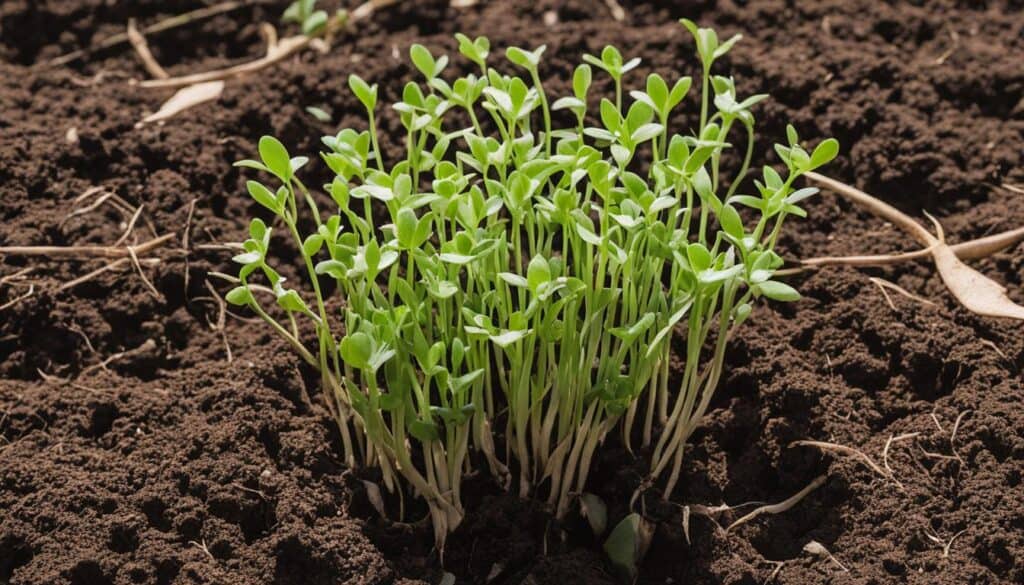
Young strawberry plants take time to mature and reach their full fruiting potential. It’s important to understand that the first year is primarily dedicated to root development, so it’s normal for these plants not to produce significant fruit during this time.
By allowing the plants to focus on establishing a solid root system, you are setting the foundation for future growth and abundant fruit production. Patience is key when it comes to growing strawberries, as the second year is when you can expect a bountiful harvest.
“The first year is all about getting your young strawberry plants to settle in and develop strong root systems. Don’t worry if you don’t see much fruit during this time; it’s a sign that your plants are establishing themselves for future growth.”
During the second year, you’ll start to see the results of your patience and care as the plants allocate energy towards flowering and fruiting. It’s an exciting time for strawberry growers, as the small, white blossoms transform into luscious, red berries.
By understanding and embracing the natural growth cycle of strawberry plants, you can maximize their fruiting potential and enjoy a plentiful harvest in the years to come.
Imbalanced Fertilizing
Imbalanced fertilizing can have a significant impact on the health and flowering of your strawberry plants. Whether it’s applying too little or too much fertilizer, finding the right balance is crucial for optimal plant growth and fruit development. Nutrient deficiencies, particularly in potassium, can lead to an imbalance that results in an abundance of leaves but no flowers.
To address this issue, it’s essential to provide your strawberry plants with the necessary nutrients to promote flower and fruit production. Applying a balanced slow-release fertilizer with a 12-12-12 NPK ratio or a potassium-rich fertilizer can help restore the nutrient balance and enhance the overall health of your plants.
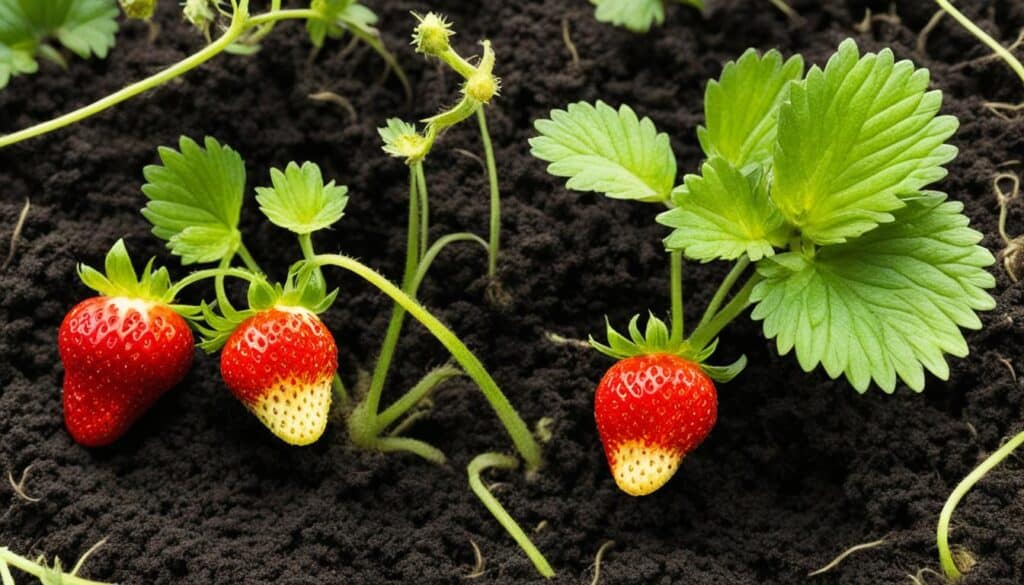
Did You Know? Imbalanced fertilizing can affect your strawberry plants’ ability to produce flowers and fruits.
Nutrient Deficiencies and Strawberry Plant Health
Nutrient deficiencies can manifest in various ways, and they have a direct impact on strawberry plant health and overall productivity. Potassium, in particular, plays a vital role in promoting flower development and enhancing fruit yield. Without an adequate supply of potassium, strawberry plants may experience stunted growth and fail to produce flowers.
Quick Tip: To ensure your strawberry plants receive the right nutrients, it’s beneficial to conduct regular soil tests to determine any deficiencies or imbalances. This information will help you choose the appropriate fertilizers to provide your plants with the necessary nutrients for optimal growth and fruit production.
| Nutrient | Function | Deficiency Symptoms |
|---|---|---|
| Potassium | Enhances flower development and fruit yield | Lots of leaves but no flowers; stunted growth |
| Nitrogen | Stimulates vegetative growth | Excessive foliage growth with limited fruiting |
| Phosphorus | Promotes root development and overall plant growth | Weak root system and stunted growth |
Applying a Balanced Fertilizer
When it comes to addressing imbalanced fertilizing, choosing the right fertilizer is key. Slow-release fertilizers with a balanced 12-12-12 NPK ratio provide a comprehensive mix of essential nutrients, including potassium, nitrogen, and phosphorus. This ensures that your strawberry plants receive a consistent supply of nutrients over an extended period, promoting healthy growth and reliable flower production.
If you suspect a potassium deficiency in your plants, using a potassium-rich fertilizer can help rectify the imbalance. Look for fertilizers with a higher potassium content, such as those labeled as “0-0-60” or “0-0-50,” to boost flower and fruit development.
Expert Tip: Remember to follow the instructions on the fertilizer package for application rates and timings. Over-application of fertilizer can lead to nutrient imbalances and other adverse effects on your strawberry plants’ health.
Unsuitable Weather Conditions
When it comes to strawberry plant growth, weather conditions play a crucial role. These delicate plants thrive in a specific range of temperatures, typically between 60-80 degrees Fahrenheit. If the weather is consistently too hot or too cold, it can hinder their ability to flower and produce fruit.
Extreme heat can cause stress to the plants, leading to reduced flower production and poor fruit set. Similarly, freezing temperatures during the blooming period can damage the flowers and prevent them from setting fruit.
To ensure optimal strawberry plant growth and encourage flowering, it is important to protect the plants from unsuitable weather conditions. Here are some measures you can take:
- Provide shade during hot summer days to protect the plants from the scorching sun. Use shade cloth or lightweight row covers to create a shaded environment.
- In colder temperatures, cover the plants with frost blankets or plastic tunnels to provide insulation and keep them warm.
- Consider planting strawberries in containers or raised beds, as they can be moved to more favorable locations if needed.
- Monitor the weather forecasts regularly and take preventive measures in advance to protect your plants.
By ensuring the strawberry plants are protected from unsuitable weather conditions, you can create an environment that promotes flowering and fruit production.

Strawberry plants require the right balance of temperature to thrive and produce bountiful fruit.
Nutrient Deficiency
Ensuring that your strawberry plants receive the proper nutrients is crucial for their health and optimal fruit production. A lack of essential organic components can lead to nutrient deficiency, hindering the growth and fruiting of your plants.
One key nutrient that strawberry plants require is potassium. This mineral plays a vital role in various plant functions, including flowering and fruit development. Without an adequate supply of potassium, your plants may struggle to produce fruits.
To address nutrient deficiency in your strawberry plants, it is essential to provide them with the necessary nutrients they need to thrive. Incorporating organic fertilizers or compost can help enrich the soil and improve nutrient availability.
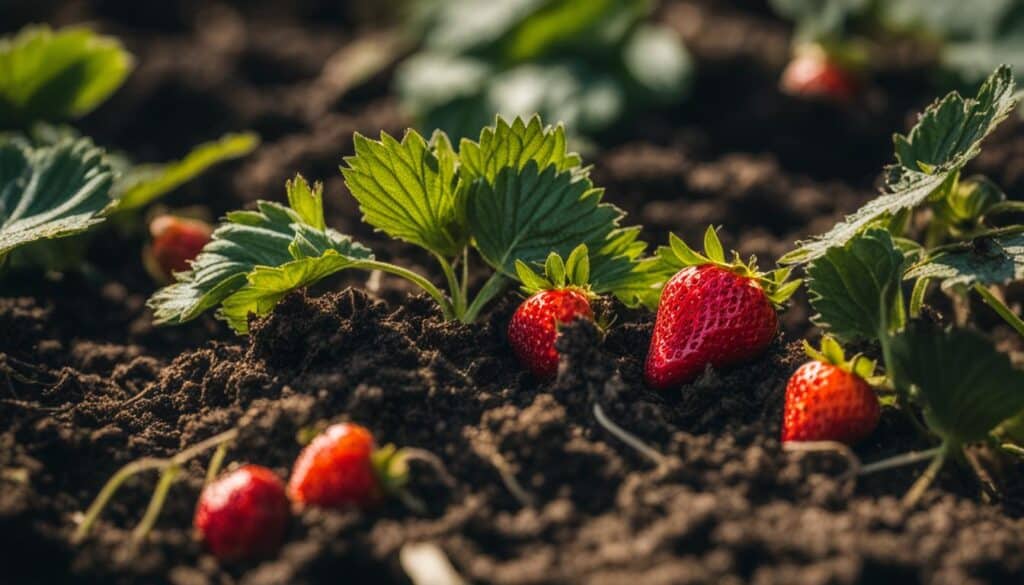
The Role of Potassium in Strawberry Plant Health
Potassium is an essential nutrient that contributes to overall plant health and plays a vital role in fruit production. It helps regulate water movement in the plant, promotes root development, and enhances the plant’s ability to withstand stress from pests, diseases, and unfavorable weather conditions.
When strawberry plants lack sufficient potassium, they may exhibit signs of nutrient deficiency. These symptoms include stunted growth, yellowing leaves, and reduced flower and fruit production.
“Proper potassium nutrition in strawberry plants is essential for healthy growth, strong root development, and optimal fruiting.”
To ensure that your strawberry plants receive adequate potassium, you can use potassium-rich organic fertilizers or incorporate materials such as wood ash into the soil. Regular soil testing can also help assess nutrient levels and guide your fertilization practices.
By providing your strawberry plants with the necessary nutrients, particularly potassium, you can promote their overall health and improve their fruiting capabilities.
Soil pH Imbalance
Strawberry plants require well-drained soil with a balanced pH level between 5.5 and 7.0 for optimal growth and fruit production. The soil pH, which represents the level of acidity or alkalinity in the soil, plays a crucial role in strawberry plant health.
If the soil becomes too alkaline or too acidic, it can adversely affect the availability of essential nutrients for the plants. This imbalance can hinder their ability to flower and, consequently, reduce fruit yield. To ensure the ideal pH level for strawberries, it is necessary to make appropriate amendments to the soil.
Amending Soil pH:
- For soil that is too alkaline (high pH), sulfur can be added to lower the pH level. Sulfur can be applied according to the instructions on the package, and care should be taken to avoid over-application, as it may harm the plants.
- Conversely, for soil that is too acidic (low pH), lime can be added to raise the pH level. Lime application should also follow the recommended guidelines, as excessive use can negatively impact plant health.
By adjusting the soil pH to the appropriate range, you can create the optimal conditions for strawberry plant health and ensure they receive the necessary nutrients for robust growth and abundant fruiting.
Recommended Soil pH for Strawberry Plants
| Soil pH Level | Suitability for Strawberry Plants |
|---|---|
| Below 5.5 | Too acidic; adjustment with lime recommended |
| 5.5 – 7.0 (optimal range) | Ideal for healthy strawberry plant growth |
| Above 7.0 | Too alkaline; adjustment with sulfur recommended |
Remember, maintaining the right soil pH level is essential to provide the ideal conditions for strawberry plants and promote their overall health and fruiting success.
Pest and Disease Control
Pests and diseases can significantly impact strawberry plants, causing stress and preventing flowering. To ensure the health and productivity of your plants, it is crucial to implement effective pest control and disease management strategies. Regular monitoring and timely intervention are key to protecting your strawberry plants and promoting flower production.
Pest Control
When it comes to pest control in strawberry plants, it is essential to identify common pests and take appropriate measures to prevent or eliminate them. Some common pests that can affect strawberry plants include:
| Pest | Description | Treatment |
|---|---|---|
| Lygus Bugs | Lorem ipsum dolor sit amet, consectetur adipiscing elit. Sed sit amet ligula at orci eleifend tristique id ut odio. | Lorem ipsum dolor sit amet, consectetur adipiscing elit. Sed sit amet ligula at orci eleifend tristique id ut odio. |
| Aphids | Lorem ipsum dolor sit amet, consectetur adipiscing elit. Sed sit amet ligula at orci eleifend tristique id ut odio. | Lorem ipsum dolor sit amet, consectetur adipiscing elit. Sed sit amet ligula at orci eleifend tristique id ut odio. |
| Spider Mites | Lorem ipsum dolor sit amet, consectetur adipiscing elit. Sed sit amet ligula at orci eleifend tristique id ut odio. | Lorem ipsum dolor sit amet, consectetur adipiscing elit. Sed sit amet ligula at orci eleifend tristique id ut odio. |
Implementing pest control measures, such as using insecticides or introducing beneficial insects, can help manage pest infestations and prevent damage to your strawberry plants.
Disease Management
Strawberry plants are susceptible to various diseases that can hinder their growth and fruiting potential. Timely disease management is crucial to protect the plants and promote flower production. Some common diseases affecting strawberry plants include:
| Disease | Description | Treatment |
|---|---|---|
| Root Rot | Lorem ipsum dolor sit amet, consectetur adipiscing elit. Sed sit amet ligula at orci eleifend tristique id ut odio. | Lorem ipsum dolor sit amet, consectetur adipiscing elit. Sed sit amet ligula at orci eleifend tristique id ut odio. |
| Powdery Mildew | Lorem ipsum dolor sit amet, consectetur adipiscing elit. Sed sit amet ligula at orci eleifend tristique id ut odio. | Lorem ipsum dolor sit amet, consectetur adipiscing elit. Sed sit amet ligula at orci eleifend tristique id ut odio. |
| Botrytis Fruit Rot | Lorem ipsum dolor sit amet, consectetur adipiscing elit. Sed sit amet ligula at orci eleifend tristique id ut odio. | Lorem ipsum dolor sit amet, consectetur adipiscing elit. Sed sit amet ligula at orci eleifend tristique id ut odio. |
Applying fungicides, practicing proper sanitation, and removing infected plants are some effective disease management techniques. It’s important to follow recommended guidelines and consult with professionals for appropriate treatment options.
By implementing effective pest control and disease management practices, you can protect your strawberry plants, promote flower production, and ensure a healthy and abundant harvest of delicious strawberries.
Conclusion
To maximize strawberry plant fruit production and improve fruit yield, it is essential to address various factors that can hinder their growth and productivity. By understanding and addressing potential issues such as poor growing conditions, watering problems, pests or diseases, improper fertilizing, and the age of the plant, you can significantly enhance fruit yield and enjoy a bountiful strawberry harvest.
Creating optimal growing conditions is crucial for strawberry plants. Ensure they are planted in well-draining, organic soil and exposed to a combination of warm days and cool nights. Consistent and appropriate watering is necessary to avoid dry soil or excessive moisture, both of which can negatively impact fruit production.
Regular monitoring for pests and diseases is vital to maintain strawberry plant health. Proper pest control measures and disease management practices can protect plants from infestations and infections that can impede fruiting. Additionally, providing the right balance of nutrients and maintaining proper soil pH levels will support optimal growth and fruit development.
By implementing these strategies and taking diligent care of your strawberry plants, you can enhance fruit production, improve yield, and enjoy the delicious rewards of your efforts in the form of a plentiful and flavorful strawberry harvest.
FAQ
Why are there no fruits on my strawberry plants?
Lack of fruit on strawberry plants can be due to poor growing conditions, improper watering, pests or diseases, poor fertilizing, and the age of the plant.
What are some poor growing conditions that can affect fruit production on strawberry plants?
Poor growing conditions such as excessively hot weather or a cold snap during bloom can hinder the fruiting of strawberry plants.
How does watering affect fruit production on strawberry plants?
Strawberry plants require consistent moisture, and both too little or too much water can affect fruit production. Dry soil can lead to limited fruiting, while excessive water can rot the plant’s crowns and hinder growth and fruiting.
Can pests or diseases impact fruit production on strawberry plants?
Yes, pests like Lygus bugs and diseases like root rot can hinder strawberry plants’ ability to produce fruit. Regular monitoring and appropriate treatment are important to prevent or manage these issues.
How does poor or improper fertilizing impact fruit production on strawberry plants?
Poor or improper fertilizing can affect strawberry plant health and flowering. Insufficient nutrients, particularly potassium, can result in lots of leaves but no flowers. Applying a balanced 12-12-12 NPK slow-release fertilizer or potassium-rich fertilizer can help promote flower and fruit development.
Does the age of the plant affect fruit production on strawberry plants?
Yes, most strawberry varieties produce little to no fruit in the first year as they focus on establishing strong roots. Pinching off flower buds during the first year allows the plants to prioritize root development. In the second year and beyond, the plants will have established roots and can dedicate energy to flowering and fruiting.
How does imbalanced fertilizing impact strawberry plant health and fruiting?
Imbalanced fertilizing, either too little or too much, can affect strawberry plant health and flowering. Insufficient nutrients, particularly potassium, can result in lots of leaves but no flowers. Applying a balanced 12-12-12 NPK slow-release fertilizer or potassium-rich fertilizer can help promote flower and fruit development.
Can unsuitable weather conditions affect fruit production on strawberry plants?
Yes, if the weather is consistently too hot or too cold, it can hinder flowering and fruit production on strawberry plants. Protecting the plants from extreme heat or providing warmth in colder temperatures can help encourage flowering.
How does nutrient deficiency impact fruit production on strawberry plants?
Nutrient deficiencies, particularly a lack of proper organic components, can hinder fruit production on strawberry plants. Providing the plants with the necessary nutrients, such as potassium, is crucial for healthy growth and fruiting.
Does soil pH imbalance affect fruit production on strawberry plants?
Yes, strawberry plants require well-drained soil with a pH between 5.5-7.0. If the soil is too alkaline or too acidic, it can affect nutrient availability and the plants’ ability to flower. Adjusting the pH with appropriate amendments, such as sulfur or lime, can help create optimal conditions for strawberry plant health.
How does pest and disease control impact fruit production on strawberry plants?
Pests and diseases can stress strawberry plants and prevent flowering. Regular monitoring and proper control measures, such as using insecticides for pests or beneficial bacteria and fungicides for diseases, can help protect the plants and promote flower production.
What can I do to improve fruit yield on my strawberry plants?
To improve fruit yield on strawberry plants, it is important to address potential issues such as poor growing conditions, watering problems, pests or diseases, improper fertilizing, the age of the plant, imbalanced fertilizing, unsuitable weather conditions, nutrient deficiencies, soil pH imbalance, and pest and disease control. Taking appropriate measures and providing the plants with proper care and nutrients will help boost fruit yield and enhance your strawberry harvest.

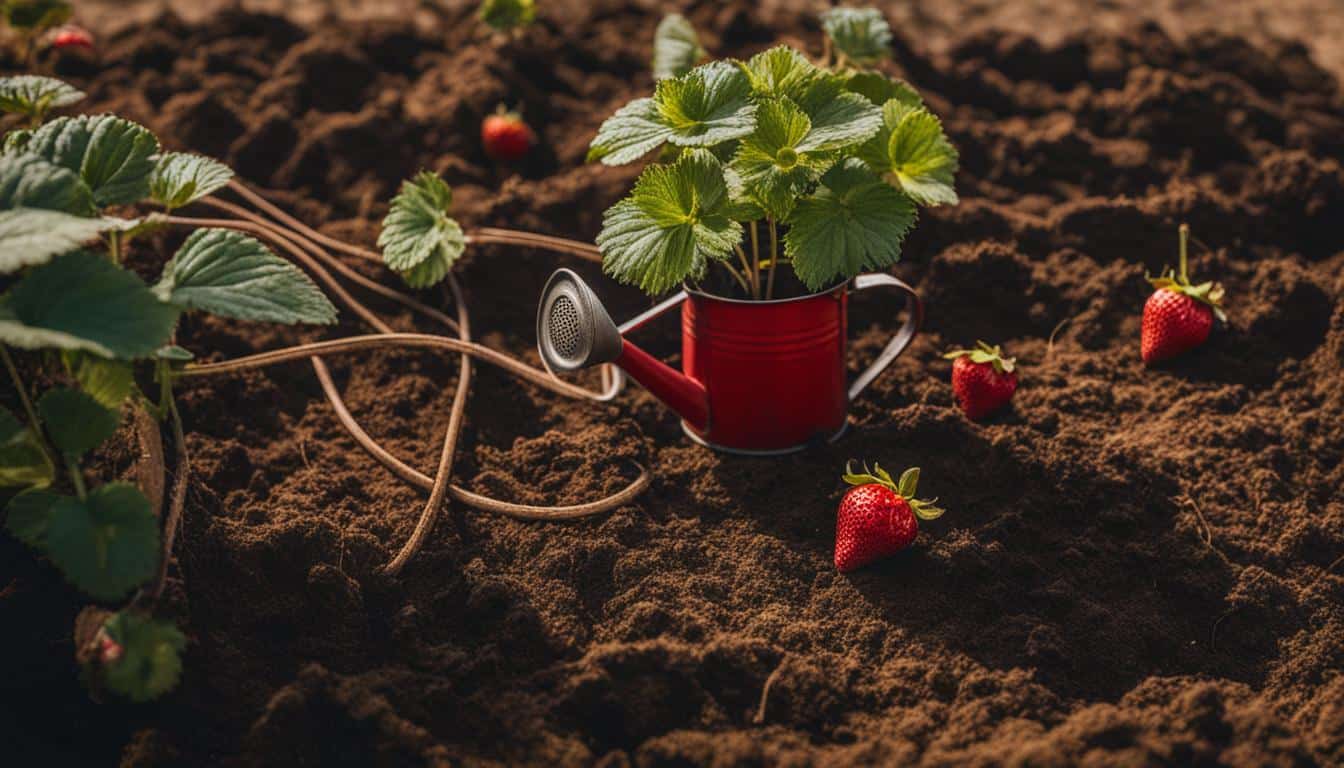



Leave a Reply